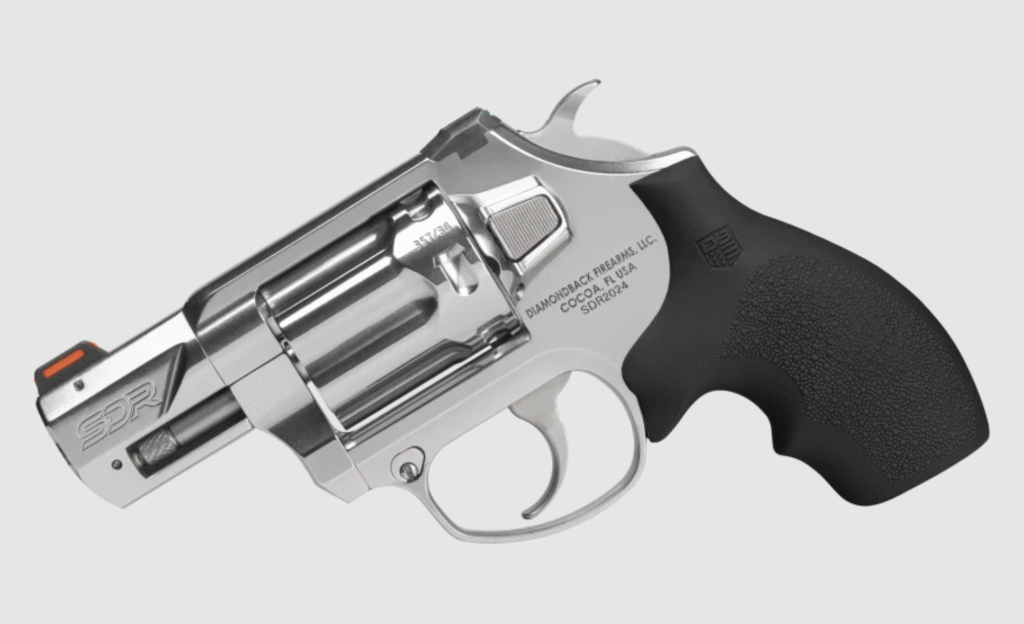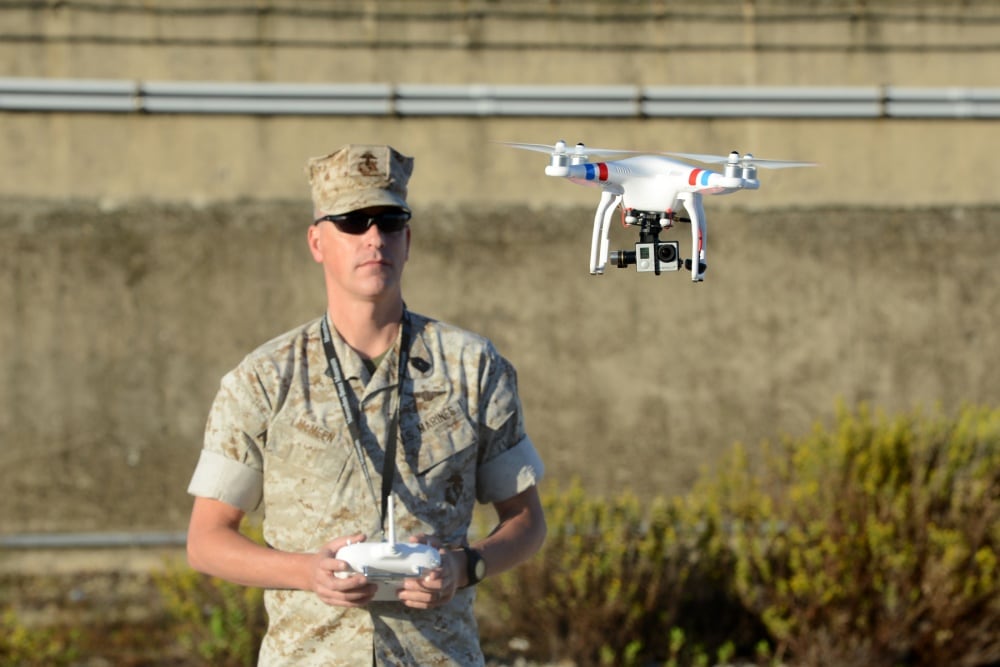“25 terms you should know to understand the gun control debate”
This title and link of an article posted by LI Herald, I believe from Stacker originally has the subheading goes thusly,
“Gun control is one of the most heated political topics in the United States. Stacker has compiled a list of 25 terms to help you understand the news, debate, and public conversation.”
It is noble and right to try and aid people in their understanding of a topic. There is just one, repeated, problem in this article.
Advertisement — Continue Reading Below
The Herald keeps getting things confusingly, often egregiously, wrong. That or Stacker did and they are sharing it without comment, correction, or verification. This is perhaps the most often repeated and most fundamentally frustrating error gun control advocates, and some gun rights advocates, make in their arguments. They are armed (pun intended) with misunderstood, misremembered, inaccurate, or entirely fabricated information.
Definitions matter.
Words matter.
Advertisement — Continue Reading Below
Understanding and comprehension matters.
Assisting your audience in understanding matters. What we cannot substitute, even as we give our opinions, is our opinions for the general understanding.
I won’t now and never will claim that my writings are without error, they are not. However, I make a genuine effort with every post, and my writers do as well, to have our facts straight and our opinions be clearly our opinions. When you are enumerating a list to better people’s understanding of a topic, at the least so they have reference points, those points must be accurate in the first place. The Herald and Stacker do not accomplish this.
Advertisement — Continue Reading Below
The post goes on to call these 25 terms critical, and then fails at making these terms remotely understandable or accurate. They fail in a variety of ways, which at least adds flavor to the failure I suppose.
Before we get to the list, I want bring attention to this line in the opening few paragraphs. The line makes the token attempt to appear balanced, does a passable job at it even, but then becomes an early indicator they are under equipped to be dealing in this advice to begin with.
Gun advocates argue that more guns, not less, will help to prevent or stop shootings—and that stricter gun-control laws will only keep guns out of the hands of honest people.
Advertisement — Continue Reading Below
This is a drastic oversimplification of several different arguments that gun controllers meld into a single inaccurate one that they assign to firearms rights advocates. I don’t know a single gun advocate, informed to any level I would deem worth listening to, who is just preaching “more guns” will solve the numerous criminal problems, mental health problems, and prevent mass shootings.
They, informed firearm advocates, do point out one or more of the following,
- The proposed law or policy being discussed would not prevent the event it is in response to…
- Current laws failed to prevent the tragedy, the tragedy wasn’t legally permitted under current law…
- Hard security measures are most effective, but are only as effective as they are stingently applied and adhered to. This includes the decisions on armed staff and to what degree…
- Disarming the law abiding at an event or place doesn’t make it safe…
- In addition there is little evidence that it markedly improves safety…
- Gun violence is complex and motivations should be the focus, not ineffectually curtailing ownership…
- Gun control disproportionately negatively affects minorities and impoverished communities…
But all of these more nuanced comments get lumped into the “you just think more guns is the answer” pile of dimwitted hot takes. That is disappointing.
Advertisement — Continue Reading Below
Continuing, the final informative paragraph gives us this…
In June 2022, just over a month after the horrific shooting at Uvalde, President Joe Biden signed the Bipartisan Safer Communities Act, which incentivizes states to pass “red flag” laws,
“Red Flag Law” is known to be of dubious efficacy because it is a catch all term for a variety of pre-due process legal actions and is questionable under civil rights protections. Red Flag Laws must be nuanced and the system must have the capacity to quickly process them, our current systems boast neither capability.
Advertisement — Continue Reading Below
expands background checks for those under age 21,
This is also of questionable merit and will likely face steep legal challenges. We may instead see certain records shift to public domain instead of being sealed and see a lowering the age of ‘adult’ culpability for certain crimes like aggravated assault and homicide. Making NICS more aggressively look at those between the ages of 18-20, those who have far more limited economic means and represent a far smaller portion of the gun buying public (as they buy less of every disposable income commodity) will not curb crime.
and closes what is known as the “boyfriend loophole.”
Advertisement — Continue Reading Below
Oh that, the most overhyped non-win of the whole legislation. Close a loophole so niche that it probably won’t bother anyone.
Previous legislation had prevented those convicted of domestic abuse from owning a firearm; the new bill now includes dating partners under that restriction,
Say the whole definition or shut up about it.
Advertisement — Continue Reading Below
Domestic violence can now include dating partners who specifically never resided with the person they have been convicted of harming and whose conviction doesn’t otherwise disqualify them from firearm ownership. Domestic abuse previously was tied to residing in the same domicile/residence/address but has been modernized under the BSCA to include a situation, that it in all honesty should include, with non-resident dating partners. Reminder that this is all at the misdemeanor level.
Problems still exist in defining ‘dating’ if both parties don’t acknowledge that they were dating, but it is a valid expansion of domestic abuse definitions. But it doesn’t expand it substantially. It is such a niche situation that someone would be convicted of abusing a partner they happened to have not lived with but that the conviction was also not another prohibitive one to firearm ownership that I would be curious to see how many people in a given year actually hit this category. I’m not kidding in the slightest when I say I believe it would be single digits, and there will be years nobody fits this specific conviction criteria.
in addition to spouses and former spouses.
Again, and any co-habitants. You don’t need to be dating, just have lived legally together. Roommates can be and have been convicted of domestic violence.
In some respects, this bill is a rebuttal to the Supreme Court’s ruling, which had been handed down just days before the signing of the bill, that effectively nullified New York state’s concealed carry law.
Yeah, we knew this was political not productive.
Seeing as gun control will continue to be a major legislative issue for years to come, here are 25 terms critical to understanding and participating in the conversation.
Critical. Critical! Yet they cannot be bothered to get them correct.
Observe.
Gun Control Act of 1968
Okay, decent start. This is one of the most defining firearms laws of the modern age and one with so many issues it had to be corrected in 1986. How do you define this substantial piece of legislation?
The Gun Control Act of 1968 set the legal precedents for the sale of guns in the United States. It determined licensing requirements, restrictions on who could purchase firearms, and regulation of interstate trading.
Huh, really swinging for brevity here without touching on any of the problem points. This lends an unconscious bias to an uniformed reader that the GCA was largely without problems. It was full of problems. The Firearm Owners Protection Act was a roll back of the GCA in many respects because gun owners had been bent over and hammered with the egregious GCA.
Firearm Owners Protection Act
Ah, that’s up next. How is it defined?
Enacted in 1986, the Firearm Owners Protection Act addressed aspects of the 1968 law that were seen by many as going too far. It loosened regulations of interstate transfers, some gun sales, and record keeping.
Again brevity. No detail on how or why.
I will give them credit that they link to the laws so the reader can see the whole thing, those links are preserved. But I would like to see more detail in the piece. Highlighting the legal purpose, problems, and scope of the laws themselves. Why did the FOPA need to counter the GCA?
In this telling it just feels like gun owners threw a tantrum and got listened to instead of their being massive and objective errors in the GCA’s approach. It treats legal proceedings like back and forth shouting matches that lack objective constitutional standards or data, that’s problematic.
Unless a reader takes the time to read the GCA, FOPA, and NFA, the terms do nothing to inform them in the debate. They are however given orientation on informing themselves by reading the laws and following up on available data about their implementation, errors in enforcement, and success in criminal intervention.
Title II, NFA weapons
By federal law, Title II and National Firearm’s Act weapons are heavily regulated. They include short-barreled shotguns and rifles, automatic shotguns, submachine guns, machine guns, rocket launchers, and grenade launchers. The acquisition of these weapons requires approval by the federal Bureau of Alcohol, Tobacco, Firearms and Explosives.
I have no serious issues with this explanation, good job. Title I and Title II device definitions are often brought up as solutions to the ‘Assault Weapon’ problem. Silencers/Suppressors, which are Title II NFA Weapons, aren’t mentioned though and I think that is to avoid bring attention to the absurdity of having them on the NFA in the first place.
Assault weapons ban
The Public Safety and Recreational Firearms Use Protection Act of 1994 aimed to get certain semiautomatic weapons off the streets. It expired 10 years later. Gun control advocates complained that the act was weak, marred by loopholes that allowed manufacturers to evade the law with minor changes, and failed to ban all semiautomatic weapons. Gun rights advocates said it infringed on their constitutionally guaranteed right to bear arms and did little to deter violence.
I would add that this is specifically the Federal Assault Weapons Ban and that state bans differ in scope and timeframe. This is a specific piece of legislation, not the generalized term.
Second Amendment
The Second Amendment of the U.S. Constitution says, “A well regulated Militia, being necessary to the security of a free state, the right of the people to keep and bear Arms, shall not be infringed.” Seemingly endless debates revolve around its intent, what comprises such a militia, and the extent of its protection of individual rights to own guns.
We do, in reference to this debate, have several Supreme Court decisions, Heller, Chicago, and Bruen, which settle much of this debate. If states like California and New York would quit wasting time and tax money on fighting their unwinnable and illogically crafted legislative endeavors we could focus on more effective ways to curb criminal violence and suicides, at least from the legislative angles.
National Rifle Association
The NRA was founded following the Civil War by Union Army veterans to promote and encourage rifle marksmanship. The modern-day NRA claims 5 million members, and its lobbying arm fights for gun rights and against gun restrictions. The NRA spent more than $30 million to support Donald Trump’s bid for the presidency in 2016.
Nice Trump association play at the end there, because throwing $30 Million to the Clinton campaign would have made sense, being she is married to the man who signed the aforementioned Assault Weapon Ban? We could have just left it with the two sentences, which nicely summarize the organization, or commented on some of the current cases the NRA was or is involved in, but no we have to play the Orangeman card.
If you’re team Orangeman=Bad now you are also team NRA=Bad, no more thinking required.
March for Our Lives
Survivors of the 2018 mass school shooting created the March for Our Lives organization at Marjory Stoneman Douglas High School in Parkland, Florida. It has called for a reduction in the number of firearms in civilian hands by 30%, a mandatory federal gun buyback program for assault weapons, an Internal Revenue Service investigation into the National Rifle Association, and a re-examination of the 2008 U.S. Supreme Court ruling allowing handguns to be kept in homes.
No mention of their political ties to Mike Bloomberg and Everytown for Gun Safety, which would be fine if they hadn’t just done otherwise for the NRA above with regards to Donald Trump. If we’re calling out political ties let’s do that evenly, shall we?
Gunowners of America
Founded in 1975, the Gunowners of America (GOA) calls itself the “no compromise” gun lobby. It believes that “gun control of all forms is ineffective and unconstitutional.” The GOA positions itself as a rival to the NRA which it claims is weak at protecting the Second Amendment. The GOA is suing the Bureau of Alcohol, Tobacco, Firearms and Explosives, and is leading the legal challenge to a ban on bump stocks, an attachment sometimes used with assault weapons.
This is another succinct explanation of a term, in this case a group, proving they are quite capable of doing so. This could be referenced quickly by a reader. The GOA, FPC, and other smaller engaged organizations should be referenceable as peerage to the NRA-ILA, although sometimes taking on different cases and with differing immediate goals and leadership. The organization sizes also vary.
That assault weapon comment with the bumpstocks at the end is problematic, but only minorly compared to what is coming so we will move on.
Assault weapon
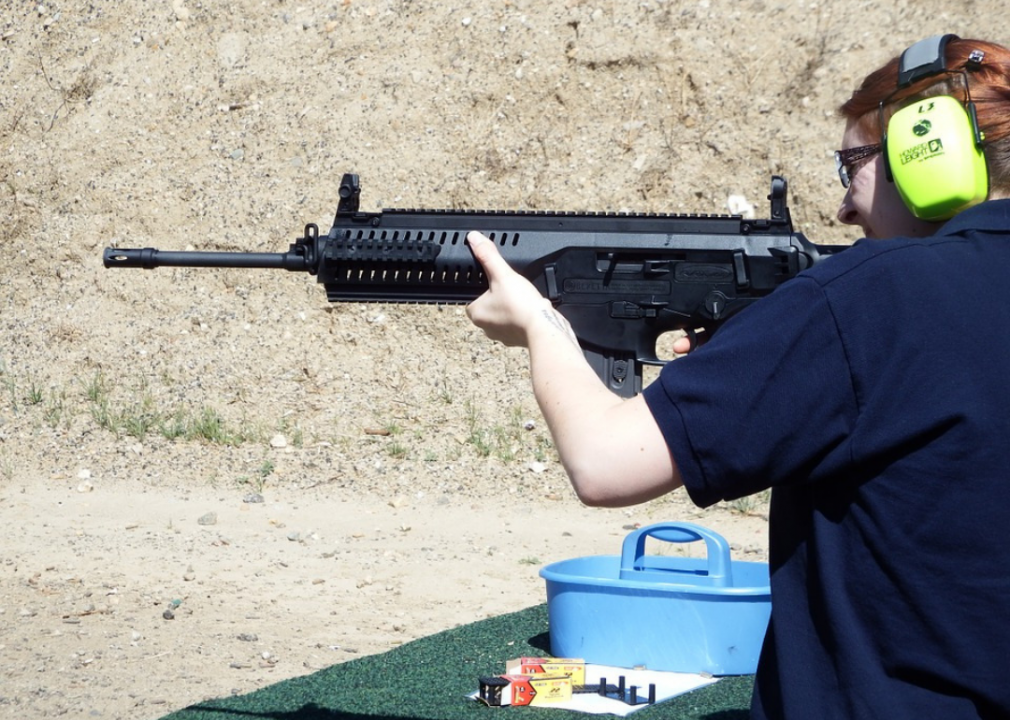
Take a look at the picture they use… Check the magazine, charging handle, and those .22lr ammo boxes on the table. Some “assault weapon” that is…
Hold on. You said Assault Weapon, not Assault Rifle. Assault Weapon is full of barrel shrouds, and pistol grips, and shoulder things that go up… You know, things absolute morons believe make weapons more lethal.
Now we’re talking about assault rifles? At least they have a fixed definition, I suppose.
Ok, continue.
can fire in fully automatic mode, meaning when the trigger is pulled and held down, the weapon will shoot continuously until the trigger is released or the gun runs out of ammunition.
…no.
You’ve screwed this one all up. First you changed terms from weapon to rifle and now you’re describing a fully automatic only machine gun instead.
An assault rifle is a select-fire rifle. This means selectable fire modes between semi-automatic and a burst, automatic, or both burst and automatic fire settings, chambered in an intermediate power rifle caliber. Intermediate calibers are those below something like 30-06, the full power rifle caliber of the first and second World Wars, but above pistol calibers like .45 ACP and 9mm NATO. The definition is fairly specific for assault rifle. Assault weapon just means some idiot who can’t be bothered to think further believes it to be scary looking.
Machine guns are assault rifles.
Again, no.
Reverse it, add context, and then yes.
Assault Rifles are Machine Guns, under the definitions of the NFA. Assault Rifles are Title II firearms. Remember the NFA, the third term of the 25 on this list? Assault Rifles are a machine gun by the terms of that 1934 law, so are all weapons capable of firing more than one shot per single action of the trigger. This covers everything from the likes of the very small VZ61 chambered in the tiny 32 ACP…
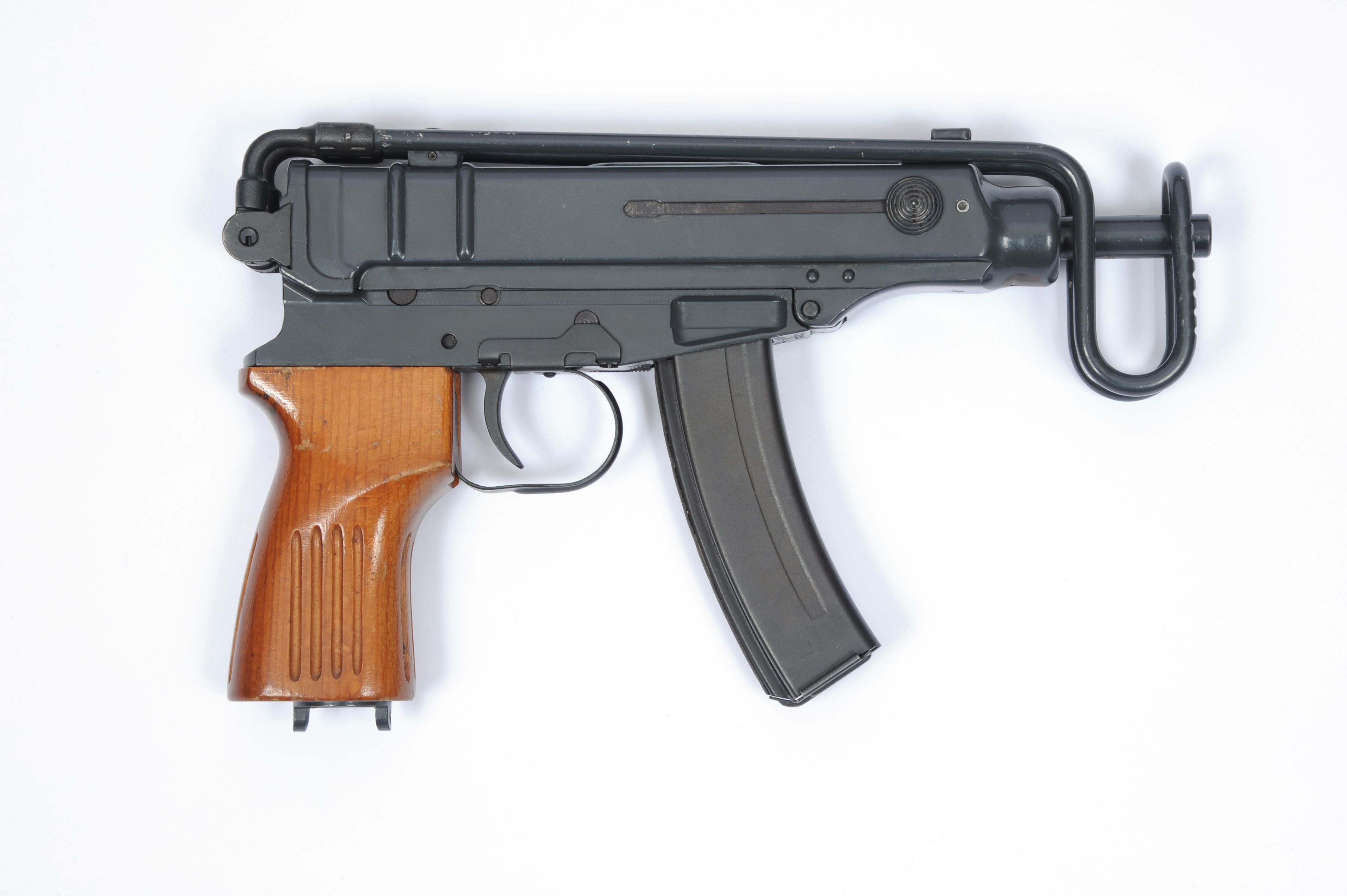
…to the M2 .50 BMG Heavy Machine Gun

The National Firearms Act considers these above two guns identical. Yep, the under 3lb .32 ACP little machine pistol is legally the same as the 128lb behemoth that can poke the horizon.
Title II. Laws are fun.
It is a politically laden term,
You couldn’t even stay on the same term to begin with, but yes. Assault weapon is a politically charged term because anyone rubbing two brain cells together in the correct observatory direction can recognize they really want it to mean semi-automatic, but they can’t get away with something that overarching.
as major gun groups say it was made up by the anti-gun lobby and that guns don’t assault people.
Assault weapon was made up by the anti-gun lobby, they have admitted that. To the best of my knowledge no firearm has ever been charged with assault, aggravated assault, or homicide and been made to stand trial, the person using one, or any other method for that matter, has been charged. So no, firearms do not assault people.
Automatic weapon
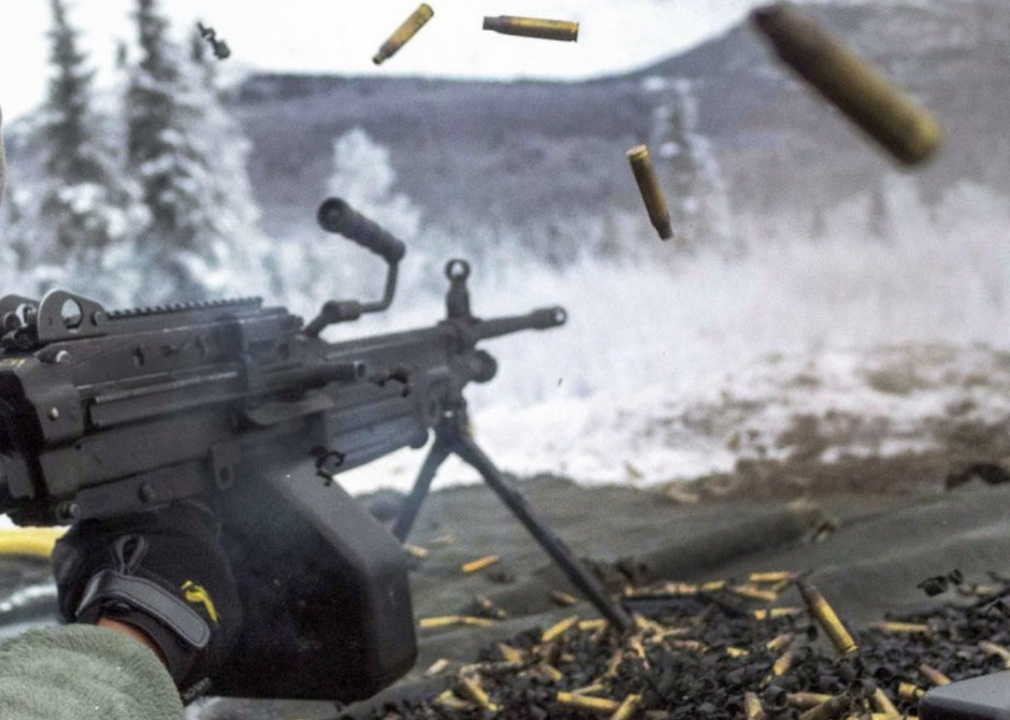
They use this image from the US Air Force of an M249.
Okay, cool so far. The SAW is an automatic weapon, hence the title Squad Automatic Weapon.
Definition?
An automatic weapon loads another round mechanically after the first round has been fired.
Nope. That is an autoloading weapon. Automatic weapons are also autoloading, but please stop mixing your functions.
It can be semiautomatic, firing one shot per single pull of the trigger, or fully automatic, loading and firing ammunition until the trigger is released, the ammunition is exhausted, or the weapon jams.
That is a select-fire weapon, like the assault rifle I clarified above. An automatic weapon is one that can only fire in, or is primarily designed to fire in, fully automatic mode. The M249 SAW, shown as the example above, can only fire in fully automatic, completely contradicting the text that follows stating it can be fired semi-auto. It cannot.
The new XM250 has a semi-automatic mode, but is meant to be fired in fully automatic most of the time. The same goes for the M2A1, it has a semi-automatic mode for administrative functions but is designed to operate in fully automatic. The Negev 5 and Negev 7 machine guns follow this trend too, with a semi-auto selection setting for administrative or select situations but designed to be fired on fully automatic for normal operation.
Semiautomatic weapon
They can’t mess this one up, right?
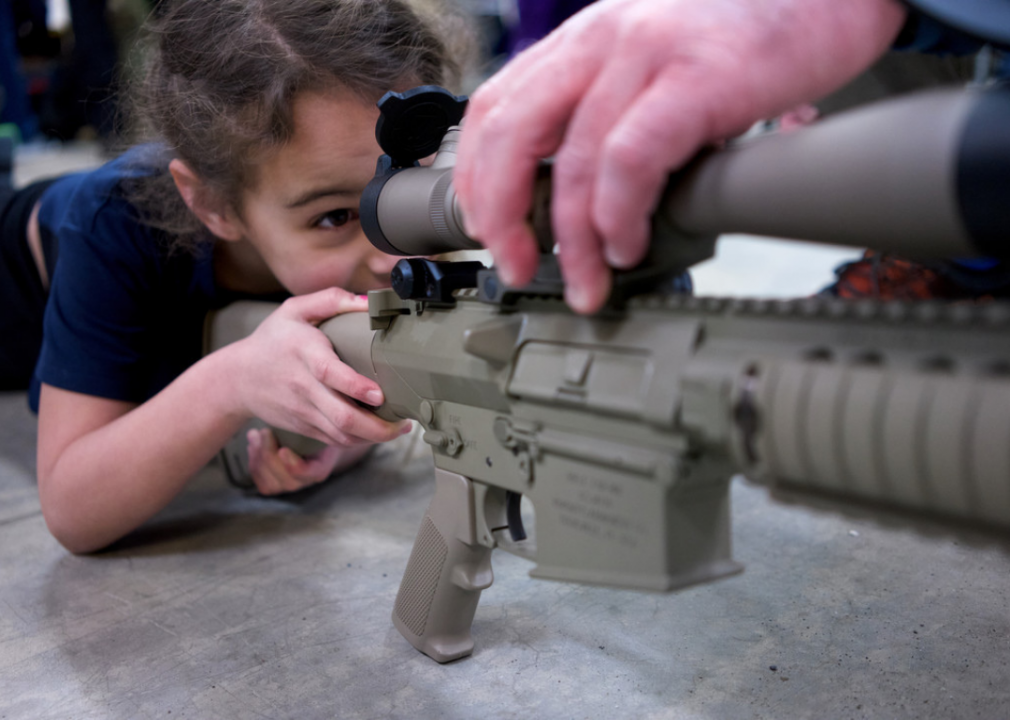
The photo choice is interesting, but still accurate. They could have just as easily used something like…
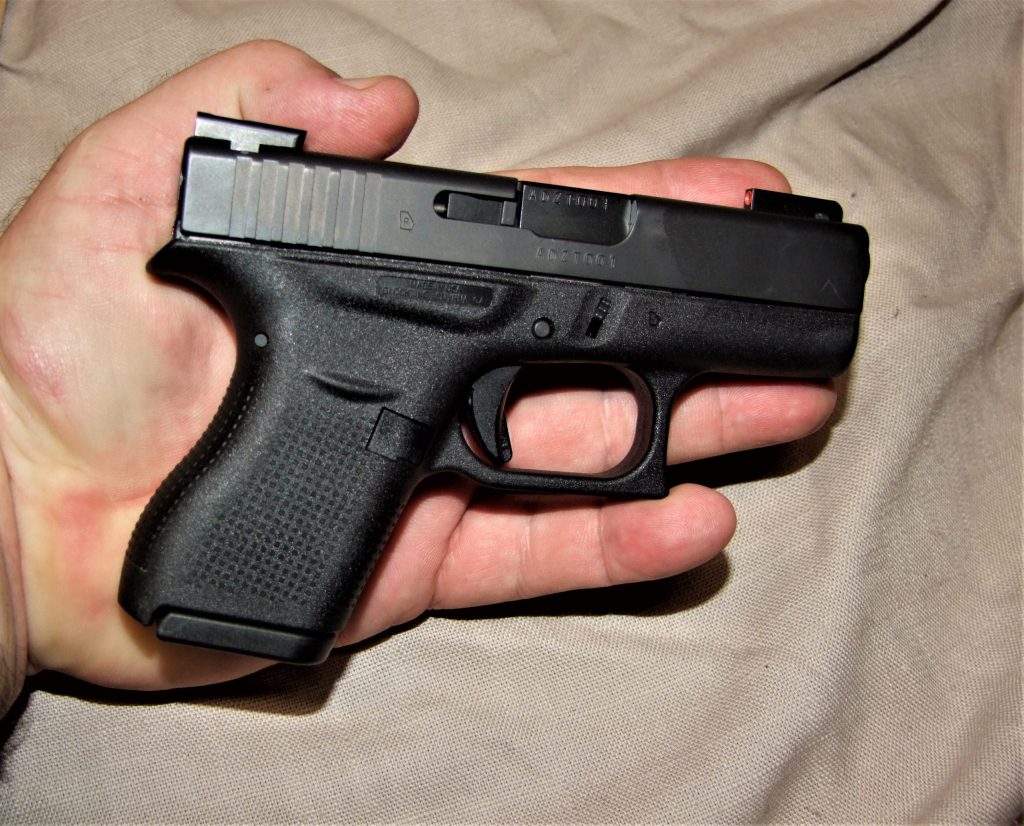
But that decision might imply that semi-automatic weapons are… common everyday firearms and not ‘weapons of war’ upon our streets.
How about the definition? How did they do?
Semiautomatic rifles fire one bullet each time the trigger is pulled, automatically loading the next round from the magazine into the chamber. They also are called self-loading rifles or auto-loading rifles.
Actually, nothing to critique there beyond the fact they switch from semi-automatic weapon to semi-automatic rifle. Changing terms mid-explanation does not lead to good comprehension of these critical terms in understanding the gun control debate, yet they continue committing this error.
Caliber
Caliber is the measure of the internal diameter of a gun’s barrel and the outside diameter of its bullet. It is measured in hundredths or thousandths of an inch—.45 handgun has a barrel diameter of 0.45 inches. It also may be measured in metrics, such as a 9mm handgun.
That’s… close. However not close enough to be helpful. Caliber is indeed the diameter of the projectile and barrel, but it primarily denotes all the dimensions of a particular cartridge so that a standard for it can be maintained. For example 45 ACP and 45-70 are very different calibers (cartridges) but are the same caliber (diameter). Stating a weapon’s caliber is denoting its full chambering, all dimensions and safe pressure to operate, not merely its bore diameter. It states the specific type of ammunition the firearm can fire. This is critical for safe operation of the firearm.
International gun control
Other developed nations have far more stringent gun laws than the United States.
The term ‘developed’ is usually an indicator that they have cherry picked a selection of high income western countries that they are going to hold up as an example for us to emulate without further denotation of differences is size, demographics, culture, criminality, economics, or history. Also why is ‘International Gun Control’ a term? Why isn’t a specific law like the GCA, but in Canada or Germany, being used and not just a vague ‘other nations have rules too.’
Oh, right. My bad. This list is already irredeemably erroneous so why should I expect it to get better going international.
For instance, Canada recently banned the sale and import of handguns.
It was already prohibited that handguns be used for anything other than target shooting at approved ranges, you weren’t even legally allowed to defend yourself with your legally owned handgun in Canada and yet somehow firearm crimes and violent crimes have still been a problem, to include a selection of mass shootings. One such shooting involved the impersonation of CMP Officer in the commission.
But I’m sure a ban will make it right, look what it did here for alcohol. Prohibition works always.
The United Kingdom bans handguns,
And has a rising knife crime problem, but at least you’re getting stabbed with sharp metal instead of fast metal?
while purchasing a gun in Japan is allowed only for hunting, professional use, and gun competitions.
The Japanese suicide rate (the majority of our gun deaths in the US are suicides) parallels our own, so that majority of deaths is independent of method. And those are pretty much the reasons to buy a firearm in the US too. Self defense could easily fall under the heading ‘ Professional Use’ but that’s just my .02.
Gun owners must document where their weapon and ammunition are stored and may not fire their guns except for the reasons they obtained them.
In the United States it is also only legal to discharge a weapon for lawful reasons. I’m not certain what they’re trying to imply here. They’ve basically summarized it that international gun law also states you can only do things that are lawful.
Russia, Mexico, and Brazil also have more stringent gun control regulations than we do, most nations do. We have the 2nd Amendment. Results of that stringent regulation vary wildly and cherry picking ‘developed’ nations defeats the purpose of the comparisons. There are numerous studies on why comparing the United States laws on firearm regulations to Europe is pointless, not the least of which is that most studies on firearm regulation in general were pointless.
Brady Law
The Brady Handgun Violence Prevention Act of 1993, known as the Brady Law, imposed a five-day waiting period after a person applies to purchase a gun. It was passed after then-White House Press Secretary Jim Brady was shot and badly wounded during an assassination attempt on President Ronald Reagan in 1981. Now, the waiting period is streamlined to take just minutes under the FBI’s National Instant Criminal Background Check System.
This explanation leaves out several crucial details about the system, specifically its flaws and limitations. Firstly, times can vary wildly depending on how quickly NICS processors are working, or if the system is working at all. Secondly, delays are common which take days to resolve and are often reported in the media as purchase denials, which they are not. Thirdly, there is a transfer date the FFL can use that if NICS does not complete the check by, the purchaser may pick up their firearm. Fourthly, not all background checks are completed. Not just within the Brady Transfer Date given by NICS, but ever. Some just remain open with no resolution, leaving a citizen in permanent limbo if it weren’t for the Brady Transfer Date portion of the law.
Gun control advocates will talk about removing the Brady Transfer Date from the law, arguing that a background check must be ‘completed’ and closed by the FBI before a transfer/sale is completed. As stated above this would leave people in limbo and deny them their constitutional rights unless a mandated time frame and mandated accuracy of records was enforced upon the FBI. They won’t accept those provisions and congress won’t force it upon them, hence the Brady Transfer Date.
National Instant Criminal Background Check System
The National Instant Criminal Background Check System, mandated by the 1993 Brady Law, is a database containing information to determine if a buyer is eligible to purchase a gun. It is used by licensed dealers before ringing up a sale. More than 1.3 million sales have been denied under this system, according to the FBI.
And over 434,836,997 checks have been performed, according to the FBI, making the national denial rate about 0.29%. Only 1 in every 334 people checked were denied their purchase. Among those that passed are several very notable killers who went on to commit mass shootings, like in Las Vegas.
So for those crowds shouting ‘Background Checks Work!’… do they?
Gun show loophole
The so-called gun show loophole refers to the legal exemption that allows private sellers, such as gun show vendors,
STOP! I’m tired of this.
to sell weapons without conducting background checks. While federally licensed gun sellers must run background checks, not all sellers must be licensed.
Vendors, those who set up a booth and are selling firearms at a show all have FFLs because you MUST have an FFL to sell firearms for profit and FFLs are required to do background checks. What you’re talking about is when private citizen A is walking around with a gun at the show, not a professional vendor, and private citizen B wants to buy it and they agree. Citizen A, again not a professional vendor, might even have a price tag on the gun they’re selling. Certain gun shows have amended their rules and disallowed this behavior, requiring them to pay for a background check at a willing vendor to do the transfer at the show.
To sell guns as a business you must have an FFL, conduct checks, and mark the paperwork for the gun show you are participating in. You cannot legally be in the business of selling firearms without an FFL and running NICS. You can, as a private citizen, sell your stuff to other private citizens. I cannot say for certain, but I would imagine most gun shows require you to be an FFL to sell guns at your vendor spot. They might not, nor are they required to if they are your private firearms unless local regulation states you must have an FFL to sell at a gun show. This necessitates more and more work arounds like parking lot sales and driving briefly away from the show to “sell” the firearm and then returning.
Those sales are known as the secondary market.
So not vendors as in businesses. Not people in the business of selling firearms for profit. A private individual selling from their private collection.
Just like the law does not make a distinction between the tiny machine gun and the massive one, the law does not make a distinction between a private citizen transfer when they happen to be standing at a gun show and one that takes place in a parking lot a block away, at a police station, or at someone’s home.
The Gun Show Loophole Closing Act of 2021 was introduced in the U.S. House in 2021, but has yet to proceed out of committee.
This is because the Gun Show Loophole (private sales) like the ‘boyfriend’ loophole (non-cohabiting dating partner) is a small niche circumstantial method to acquire a firearm and has no reliable data showing it is a remotely significant source of firearms transfers that end in serious criminal activity. Firearms that are stolen (and the ATF themselves have lost thousands) are a significantly larger and more blatant problem. The boyfriend loophole was closed purely for political points, not efficacy, and the gun show loophole is the same snake oil. It will pass if and when the legislature needs a gun control win or else.
Strawman purchase
Considered a loophole in gun control,
A loophole? It’s a Federal Crime.
Gun stores are encouraged to deny sales to anyone they suspect of straw purchasing, like someone being denied a purchase but then their buddy or their girlfriend suddenly wants to purchase it instead.
with a strawman purchase, someone who is ineligible and seeking a gun can use someone eligible to obtain the weapon. Prosecutors say it’s difficult to prove the intent of a strawman not to keep the gun, and few states have laws regulating secondhand purchases.
There’s that secondary market again. It is difficult to prove intent, but knowingly selling or transferring a firearm to someone who you know is ineligible to own one is also a crime. There are prosecutorial options, not perfect ones but they exist. But a straw purchase isn’t a loophole, its very illegal to do even if it is done anyway.
Mass shootings
The United States has more mass shootings than any other developed nation. Among the most horrific was in 2012, when a gunman killed 20 children and six adults at Sandy Hook Elementary School in Newtown, Connecticut. A shooting in 2016 at a nightclub in Orlando, Florida, that left 50 dead, was the deadliest until the following year when a gunman killed 59 people at a Las Vegas music festival. In 2018, a gunman killed 17 people at a Parkland, Florida, high school, and 22 people were killed in August 2019 at a Walmart in El Paso, Texas.
I notice here they aren’t defining mass shootings, they’re listing the most horrific ones that also qualify as a public mass casualty attacks or terroristic attacks.
While these deadly events were less frequent during the height of the COVID-19 pandemic, 2022 has seen more than 650 mass shootings as of late October,
That’s easy when you lower the definition to include nearly every criminal incident involving a gun where multiple people are injured. Even amid this ‘pandemic’ of mass shootings, our criminal and homicide rates are very middling worldwide. They could be better, they could be significantly worse. We’re the third largest nation on the planet and much of our homicide is geographic, urban, and criminally connected, this includes our ‘mass shootings’.
the deadliest of which was at Robb Elementary School in Uvalde, Texas, on May 24, which left 22 dead and another 18 injured. It took place just 10 days after a gunman opened fire at a supermarket in Buffalo, New York, killing 10 people.
Okay… what is the definition of mass shooting?
They never actually state it in their ‘understanding crucial terms’ post. They never give you the definition.
Allow me, it is most commonly any event involving a firearm where four or more people are injured or killed as a result. They do not all have to be injured or killed by gunfire. This can include the perpetrator of the event.
Bump stocks
A bump stock is an attachment designed to make a semiautomatic rifle fire faster. It replaces the weapon’s stock—the part held against the shoulder—freeing it to slide back and forth rapidly and harness the recoil energy. A dozen of the rifles used by the gunman in the 2017 Las Vegas mass shooting were modified with bump stocks, allowing him to fire over 1,100 rounds in 11 minutes. Bump stocks are illegal for almost all U.S. civilians; despite suits filed by gun rights groups to reverse this law, the U.S. Court of Appeals upheld the federal ban on bump stocks in August 2022.
While 100 rounds a minute is very doable in regular semi-auto, it would make the finger tired. Don’t @ me or email me with your pet Vegas theory either, please. Occam’s Razor applies here. We may not like that there is no known motive, he was wealthy enough for full on automatics to be in his budget, or that it seems implausible to you that Surefire 100’s and bumpstocks would work as well as they did. But the long and short of it is that the most plausible answers are that they did work, he did what he did, and there is nothing that necessitates a crazy person having an understandable or known motive just because we are used to seeing manifestos, social media posts, videos, or other explanations for the extreme behavior.
Him shooting into the concert crowd, because ‘why not?’, is still the most plausible answer. A highly dissatisfying answer, but the best in our possession. It must therefore be taken as the most likely. I’ve heard a few alternatives that get my gears turning too, but nothing that passes Occam’s enough to be worth portraying as ‘the truth’ of the Las Vegas Mandalay Bay shooting. Facts remain that it was amateurly executed, thankfully, and resulted in a much lower casualty count than it could have had explosives and better aimed fire been used. We are lucky this guy had far more money that terroristic sense, because a trained AQ operative with his resource pile in that position would be absolutely terrifying.
Anyway, the bump stock definition itself is fair; is an attachment designed to make a semiautomatic rifle fire faster. It replaces the weapon’s stock—the part held against the shoulder—freeing it to slide back and forth rapidly and harness the recoil energy.
Binary trigger
Like a bump stock, a binary trigger increases a weapon’s firing speed. Unlike a bump stock, it is legal in many states.
This is for a very simple reason. It fits the textbook definition of semi-automatic firearm. One shot per action of the trigger. Binary triggers merely take advantage of an action that most triggers do not, the forward motion. The bumpstock got squeaked in as a machine gun in one of those times ‘something needed to be done’ about the gun violence.
A binary trigger allows the firearm to shoot one bullet when the trigger is pulled and one when it releases. Using a binary trigger, a 30-round magazine can be emptied in about three seconds.
Harkening back to the bump stock commentary, rate of fire is not correlative to casualty rates. This is demonstrable over, and over, and over again, how fast a weapon can shoot is not how fast a weapon can kill. The injury rates in many mass casualty shootings are 1:1 or 1:2 with the death rates. Per every person shot and killed, one or two people are injured. In Vegas it was closer to 1:10 despite the astronomical amount of ammunition fired and the devastatingly effective killing field that a packed outdoor concert represents. Casualty counts are much more dependent upon how many people are close to the start of the attack, how effectively they can flee that space, and if the shooter encounters effective resistance.
Pistol grip
Why is this on the list?
A pistol grip is considered a defining feature of an assault weapon.
By the brain dead.
It is used to improve stability against a weapon’s recoil.
It is used to hold onto the gun in reasonable comfort
Gun control advocates say a pistol grip helps shooters who are spray firing from the hip,
These people have watched Commando, Predator, and a number of other action movies and taken them as indisputable fact while mixing this up with a tactic carried from WWI, ironically from a weapon (the BAR) that didn’t have a pistol grip.
and the feature was prohibited under the assault weapons ban,
No it wasn’t, it was one of the absurdly asinine features used to determine if a rifle was an assault weapon or not. An AR-15 was perfectly fine if it didn’t have a threaded on muzzle device or a stock that was adjustable, it could have a pistol grip. It could also have a perfectly functional non-pistol-grip, like these…
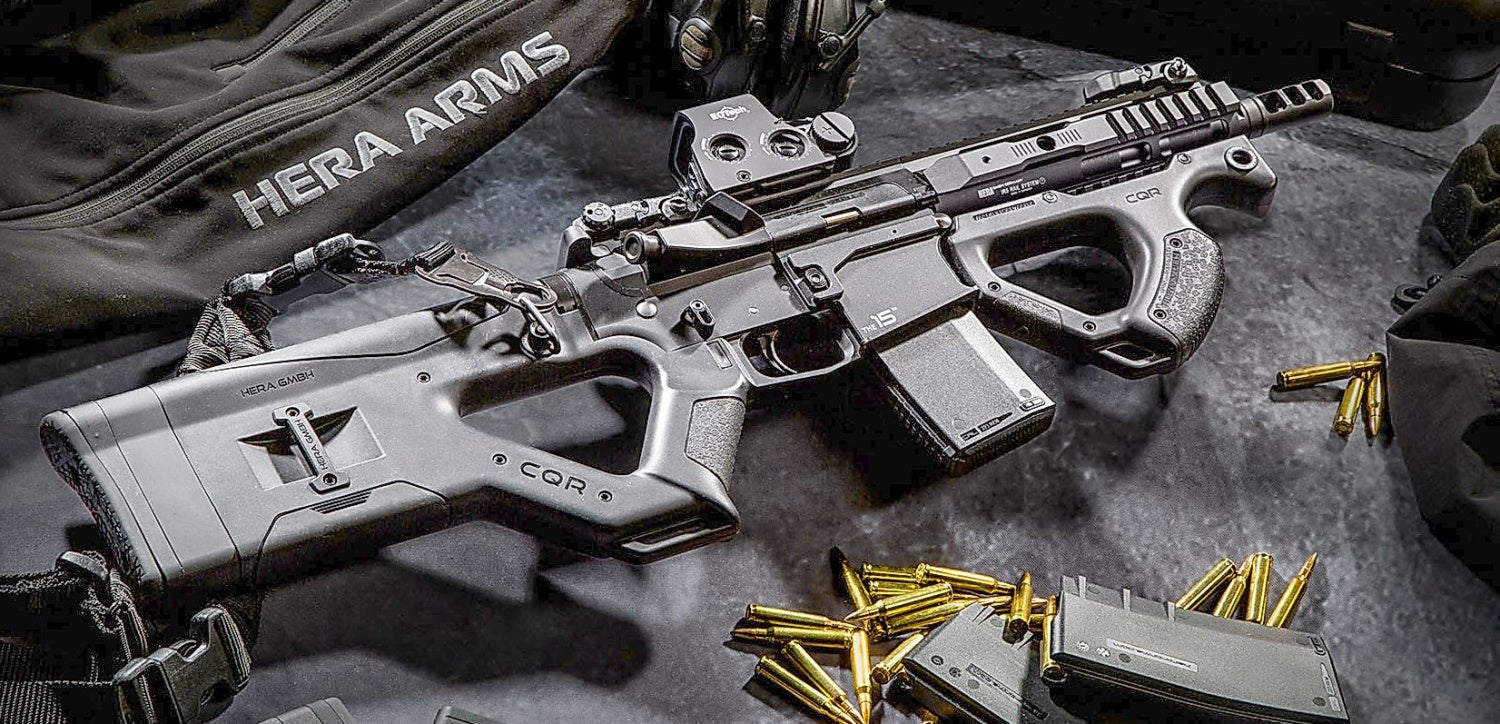
but since the ban expired, this type of grip has been difficult to regulate.
Because regulating them is asinine.
For example, California has been undergoing challenges to its assault weapons ban, which affects the use of pistol grips; gun manufacturers also alter the design of their weapons in order to circumvent regulation.
This is because the asinine regulation of a feature is stupid, it doesn’t influence the lethality of a weapon. Pistol grips don’t add +2 deadliness, this isn’t a video game.
Flash suppressor
I’m convinced at this point the author said 25 and then ran out of more relevant things to get wrong, define poorly or incompletely or skip defining entirely, or was given 25 by someone else and couldn’t change the number. They are now just picking anything to keep the list going.
A flash suppressor also is a feature of assault-style weapons. It allows hot air and gas to escape from the gun barrel, creating a smaller flash as the bullet is fired. It is designed to improve visibility for the shooter.
Hey! Full points on this one. That is what a flash suppressor does. Bummer that they can also be found on bolt action rifles.
High-capacity magazine
Definitions vary, but generally a magazine that holds more than 10 rounds of ammunition is considered high capacity. The gunman in the August 2019 Dayton, Ohio, mass shooting that killed nine people had a 100-round magazine. Using high-capacity magazines is legal in many states. Gun control advocates say that while restrictions on magazine size may not stop mass shootings, they may limit the carnage if the shooter must pause to reload.
This premise has been disproven in any multitude of ways by subject matter experts and in the evidence we have from mass shootings. The third most lethal mass shooting in the US is still Virginia Tech, where two limited capacity handguns were used. Reloading didn’t limit anything. Reloading is a task that takes a bare handful of seconds and can have no meaningful impact on the lethality of an incident. A remotely competent shooter with a low capacity pump action shotgun can kill the same nine people or more. Capacity, as with caliber or weapon type, is a very poor indicator of lethality in a mass shooting.
Open carry
Guess what flattering type of photo they use for this one…
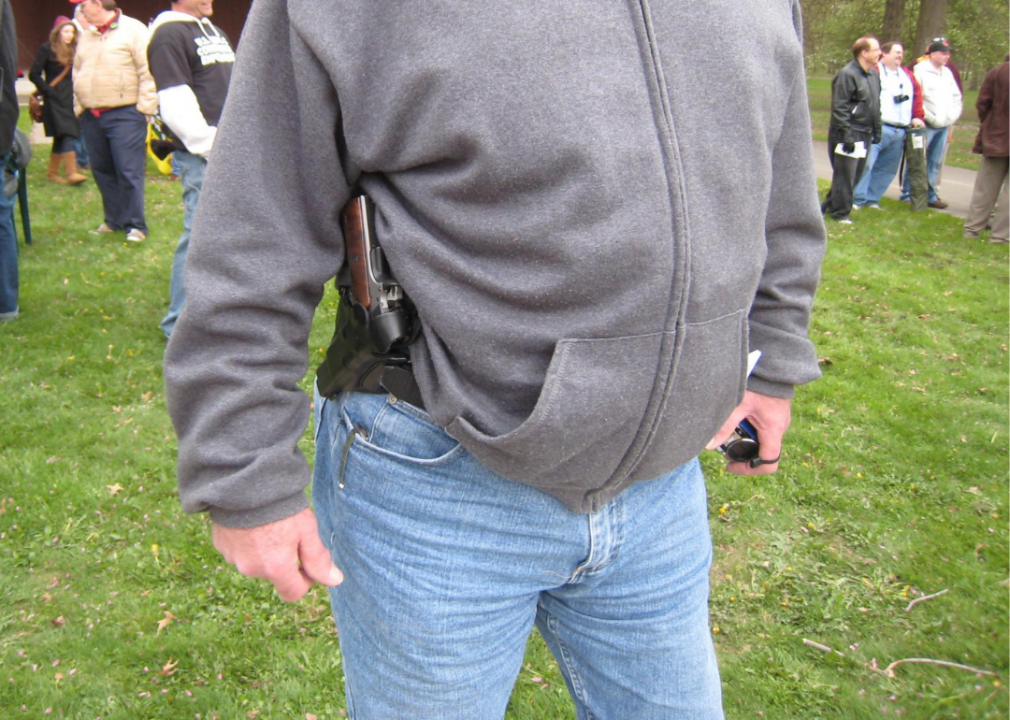
That’s right! Overweight white guy! Stereotyping is fun.
Open carry refers to the practice of carrying openly visible firearms in public.
Like the police and uniformed security.
Five states and Washington D.C. forbid the open carry of handguns in public places.
Except by the police and uniformed security.
Thirty-one states allow open carry without any license or permit, although in some cases the weapon cannot be loaded. Forty-seven states allow the open carry of a long gun, such as a rifle or shotgun, although some states do not allow the weapons to be loaded.
Except by police or uniformed security. I sure hope cops have never done anything wrong, deliberately or accidently, with firearms and that nobody around them is in the ACAB group and terrified and traumatized by their presence. That would suck being near those open carriers with arrest and detainment powers, wouldn’t it?
Background checks
Under federal law, background checks are required to buy guns from a licensed vendor, which includes retailers. Among those ineligible to buy a gun are felons, those dishonorably discharged from the military, and people convicted of domestic violence. A background check is not federally required to buy a gun from a private, unlicensed seller, including online and at gun shows.
Be certain you tie all of those back to private seller, however this is also usually within a state’s borders. The rules change when you cross state lines, if you use an FFL to mail a firearm you sold, if you use an FFL to help sell a firearm, if you are selling for profit at a gun show or if the gun show requires you use an FFL to complete private sales at the show, and any number of other ways background checks can become involved.
Gun control advocates want background checks expanded,
So we can deny/delay more constitutional rights in the vain hope we deter a monster from committing mass murder? The 0.29% of denied sales almost never result in a follow on criminal prosecution, why would more checking not continue that trend of inaction? Eroding the confidence in the law is the result. Does it matter that it is illegal to try and buy a gun as a certain type of convict? If trying to make the purchase doesn’t result in being prosecuted criminally I’d argue it doesn’t matter. The super majority of denials are never recommended for further action because they are not deemed a pressing threat of any kind. Additionally we know that many mass killers passed their background checks. Others stole their weapons. So what are background checks doing if over 99.7% of people always pass and less than 1% of the less than 1% of people who fail the check ever end up in a courtroom over it, to say nothing of convicted of a crime?
while the NRA opposes expanded checks, saying they would not stop criminals who obtain weapons through theft, the black market, relatives, or friends.
Joe Biden’s son is known to have violated this law, blatantly, admitted. Hunter Biden is an illegal possessor and lied on his background check. We have evidence of him in the commission of multiple federal crimes regarding substance abuse, prostitution, and firearm possession.
He probably won’t be convicted of it. Just like the 99+% of people who should be (because its the law, right?) and aren’t prosecuted for lying or trying to illegally possess a gun, it isn’t actually that big of a deal the vast majority of the time according to law enforcement.
So, again, what are background checks doing?
Summary
This list is a bust. If you knew nothing going in you would know nothing of worth coming out. You could get into fights with people who know far more and those who know less but feel some type of way with equal aplomb. Nothing here would better assist you in understanding firearms in the US.
It was fun to take apart though.

